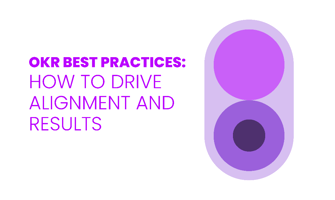OKRs (Objectives and Key Results) are a powerful goal-setting framework that helps organizations...
OKR Implementation: Strategies for Effective Execution
Implementing OKRs (Objectives and Key Results) is essential for organizations aiming to achieve their strategic goals with precision and efficiency. By setting clear objectives and measurable key results, companies can ensure everyone is aligned and focused on what matters most.
This article outlines strategies for effective OKR implementation. It covers the key practices and approaches that help ensure your organization works towards common goals efficiently and effectively. Through these strategies, you can enhance alignment, improve focus, and drive overall performance.
For a simple introduction to OKRs, read our article, "What is an OKR? A Beginner's Guide."
Understanding OKRs
OKRs, or Objectives and Key Results, are a simple way to set and track goals. Objectives are what you want to achieve, and Key Results are how you measure success.
Objectives: Clear, short goals that inspire and align with your company's vision.
Key Results: Specific, measurable outcomes that show if you’ve reached your objective.
OKRs help focus efforts by setting clear priorities. They make sure everyone works toward the same goals and improve performance by providing clear targets and accountability. OKRs keep everyone on track and moving in the same direction, helping the business grow and succeed.
OKRs help in three main ways:
Focusing Efforts: By clearly defining what needs to be achieved, OKRs help teams focus on the most important tasks.
Fostering Alignment: OKRs ensure that all team members are working towards the same goals, creating unity and direction.
Driving Performance: With clear, measurable targets, OKRs provide a way to track progress and hold everyone accountable, boosting overall performance.
![]()
Steps to Effective OKR Implementation
1. Educate Your Team on OKRs
Educating your team on OKRs means teaching everyone in the organization what OKRs are, why they are important, and how they work. This involves making sure that everyone understands the role of OKRs in aligning individual and team goals with the company’s mission. This understanding improves focus, clarity, and accountability throughout the organization.
To effectively educate your team, it's crucial to use a variety of methods that cater to different learning styles. This ensures that all team members can grasp the concept and importance of OKRs.
Workshops: Organize hands-on workshops where employees can learn about OKRs.
Webinars: Host webinars to reach remote employees and provide flexible learning options.
Comprehensive Guides: Distribute easy-to-understand guides and handbooks.
Q&A Sessions: Hold sessions to address any doubts and ensure clarity.
2. Secure Leadership Buy-In
Securing leadership buy-in means getting the commitment and support of top executives for the OKR process. This is essential because leaders set the tone for the rest of the organization. When leadership supports OKRs, it demonstrates their importance and encourages everyone else to take them seriously.
Present the value of OKRs to leadership by highlighting how they can drive organizational performance and align efforts with strategic goals. Emphasize the role of leadership in fostering a culture of accountability and continuous improvement.
Case Studies: Share success stories from other companies that have benefited from OKRs.
Data Presentation: Present data and metrics that highlight the effectiveness of OKRs.
Executive Workshops: Conduct workshops specifically for leaders to discuss OKRs and their benefits.
Ongoing Support: Ensure continuous communication and support from leadership throughout the OKR implementation process.
3. Align OKRs with Company Vision
Aligning OKRs with the company vision means setting objectives and key results that support the overall mission and long-term goals of the company. This ensures that every OKR is a step toward achieving the company’s broader goals. When employees see how their work contributes to the company’s vision, it increases motivation and engagement.
To align OKRs effectively, regularly revisit and communicate the company’s mission and vision. Make sure that strategic planning sessions involve setting OKRs that directly contribute to these goals. Clear communication is key to maintaining focus and relevance.
Mission Statements: Regularly revisit and communicate the company’s mission and vision.
Strategic Planning Sessions: Hold planning sessions to ensure OKRs are aligned with strategic goals.
Clear Communication: Use clear and consistent communication to link OKRs to the company’s vision.
Visual Aids: Create visual aids like charts and diagrams to show how individual OKRs align with the company’s mission.
4. Collaboratively Set Department and Team OKRs
Collaboratively setting department and team OKRs means working together with different departments and teams to create specific OKRs that align with the overall company objectives.
This collaborative process ensures that OKRs are realistic and achievable, encouraging a sense of ownership and accountability among team members.
Encourage participation from all team members during the OKR-setting process. This can be achieved by organizing brainstorming sessions and establishing feedback loops. Collaboration tools and cross-department meetings can also help facilitate communication and alignment.
Brainstorming Sessions: Hold sessions where team members can suggest and discuss potential OKRs.
Feedback Loops: Establish regular feedback loops to refine and adjust OKRs based on team input.
Collaboration Tools: Collaboration tools and platforms are used to facilitate communication and idea sharing.
Cross-Department Meetings: Organize cross-department meetings to ensure alignment and cohesion among different teams.
5. Define Clear and Measurable Key Results
Defining clear and measurable key results means setting specific, quantifiable outcomes that indicate whether an objective has been achieved. Clear key results provide a way to measure progress and ensure that everyone understands what success looks like.
Set key results that are specific, measurable, and time-bound. This clarity helps avoid ambiguity and ensures that key results are challenging yet attainable. Regular reviews of these key results help track progress and make necessary adjustments to stay on course.
Specific Metrics: Use specific metrics such as numbers, percentages, and deadlines to define key results.
Challenging Yet Achievable: Make sure key results are challenging enough to push for high performance but still achievable.
Regular Reviews: Conduct regular reviews to track progress and make necessary adjustments.
Success Criteria: Clearly outline the criteria for success for each key result to avoid ambiguity.
6. Assign Ownership and Responsibilities
Assigning ownership and responsibilities means designating individuals or teams responsible for each OKR to ensure accountability. When ownership is clear, it’s easier to track progress and address any issues that arise. This step is crucial for maintaining focus and actively pursuing OKRs.
Clearly defining roles and expectations is essential for effective execution. By using performance reviews, you can reinforce accountability and recognize the efforts of those who contribute to achieving OKRs. This not only keeps everyone on track but also motivates them to perform their best.
Designate OKR Owners: Assign specific individuals or teams to be responsible for each OKR.
Define Roles and Expectations: Clearly outline what is expected from each OKR owner.
Performance Reviews: Use regular performance reviews to monitor progress and accountability.
Recognition: Acknowledge and reward those who meet or exceed their OKR responsibilities.
7. Use OKR Software Tools
Using OKR software tools means choosing and implementing a software tool to manage and track OKRs effectively. These tools help streamline the OKR process, making it easier to set, monitor, and review objectives and key results.
Selecting a user-friendly tool like 180ops can facilitate transparent tracking and regular updates. 180ops combines CRM, customer service, and sales data with external data to provide real-time insights. This ensures that everyone has access to the latest information and can see how their efforts contribute to the overall goals.
Choose the Right Tool: Select a user-friendly OKR software tool.
Facilitate Transparency: Ensure the tool provides transparent tracking and regular updates.
Centralized Platform: Use the tool to centralize OKR management and information.
Regular Updates: Encourage regular updates within the tool to keep everyone informed.
8. Regular Check-Ins and Progress Tracking
Regular check-ins and progress tracking involve scheduling weekly or bi-weekly meetings to discuss progress and update the status of key results. These check-ins help keep everyone aligned and address any issues promptly.
Using a consistent meeting structure and agenda ensures that all aspects of OKR progress are reviewed and addressed. This helps maintain focus and allows for timely adjustments to keep the team on track toward achieving their goals.
Scheduled Meetings: Set up weekly or bi-weekly check-in meetings.
Consistent Structure: Use a consistent meeting structure and agenda.
Progress Reviews: Regularly review the progress of each OKR.
Timely Adjustments: Make necessary adjustments based on the progress reviews.
9. Review and Reflect at the End of Each Cycle
Reviewing and reflecting at the end of each cycle means holding a review meeting to assess achievements and identify areas for improvement. This step is crucial for understanding what worked, what didn’t, and why, helping to improve future OKR cycles.
Developing a structured review process that includes a detailed analysis ensures that you learn from each cycle. This reflective process helps identify best practices and areas that need improvement, fostering a culture of continuous learning and development.
Review Meetings: Hold a review meeting at the end of each OKR cycle.
Detailed Analysis: Conduct a detailed analysis of what worked and what didn’t.
Identify Improvements: Identify areas for improvement and best practices.
Continuous Learning: Foster a culture of learning and development.
10. Celebrate Successes and Provide Feedback
Celebrating successes and providing feedback involves recognizing and celebrating achievements to motivate the team. Constructive feedback is also essential for continuous improvement and future success.
Implementing a reward system for achieving key results can enhance motivation and performance. Providing actionable feedback helps team members understand what they did well and where they can improve, contributing to their professional growth and the organization’s success.
Recognize Achievements: Celebrate team achievements to boost morale.
Reward System: Implement a system to reward those who achieve key results.
Constructive Feedback: Provide feedback that is actionable and constructive.
Professional Growth: Use feedback to support team members' development.
11. Iterate and Improve
Iterating and improving means continuously gathering feedback and refining the OKR process based on new insights and changing business needs. This ensures that the OKR process remains relevant and effective over time.
Establishing a culture of continuous improvement involves regularly soliciting feedback and making iterative changes to the OKR process. This approach helps the organization adapt to new challenges and opportunities, ensuring sustained progress and success.
Gather Feedback: Continuously collect feedback on the OKR process.
Refine Process: Make iterative changes based on feedback and insights.
Adapt to Change: Ensure the OKR process adapts to new business needs.
Continuous Improvement: Foster a culture of ongoing improvement and development.
![]()
Challenges in OKR Implementation
1. Lack of Understanding
Teams may not fully grasp the OKR framework, leading to confusion and ineffective implementation.
Use straightforward explanations and real-life examples to make the OKR framework easy to understand. Create simple, visual guides and provide hands-on training sessions to clarify concepts.
2. Resistance to Change
Employees may resist adopting the OKR system due to unfamiliarity or discomfort with new processes.
Introduce OKRs gradually and integrate them with existing processes. Start with a pilot team to demonstrate success and gradually expand, providing continuous support and feedback.
3. Inconsistent Application
Different teams may apply the OKR framework inconsistently, leading to uneven progress and confusion.
Develop a standardized OKR process and guidelines for all teams to follow. Provide training and resources to ensure everyone understands and applies the framework consistently.
4. Lack of Engagement
Employees might not see the value in OKRs, leading to low engagement and participation.
Clearly communicate the benefits of OKRs to all employees. Show how OKRs can help them achieve their personal and team goals more effectively and how their contributions align with the company’s success.
Conclusion
OKRs are essential for setting and tracking goals in a clear, structured way. They help organizations align their efforts, focus on important tasks, and drive overall performance. By providing specific, measurable targets, OKRs ensure everyone knows what success looks like and how to achieve it.
By effectively implementing OKRs, your organization can achieve its goals more efficiently, ensuring everyone is working together towards common objectives. This leads to better focus, alignment, and success.
FAQs
What are the steps to implement OKRs in an organization?
Educate your team on OKRs, secure leadership buy-in, align OKRs with the company vision, collaboratively set department and team OKRs, and regularly review and update progress.
How do OKRs help in improving business performance?
OKRs improve business performance by providing clear goals, ensuring alignment across teams, enhancing focus on key priorities, and facilitating regular progress tracking and accountability.
What are common challenges in OKR implementation and how to overcome them?
Challenges include lack of understanding, insufficient leadership support, misalignment with strategic goals, and poor tracking. Overcome these by providing proper training, securing leadership commitment, aligning OKRs with company vision, and using tracking tools.
How to align OKRs with a company's strategic goals?
Align OKRs by setting objectives that directly support the company's mission and vision, involving leadership in the OKR-setting process, and ensuring clear communication of how each OKR contributes to strategic goals.
What are the best practices for setting effective OKRs?
Set clear, concise objectives; ensure key results are specific, measurable, and time-bound; involve teams in the OKR-setting process; regularly review progress; and adjust OKRs as needed to stay aligned with changing priorities.




